Long hair is a canvas of endless possibilities, and finding the perfect haircut can transform your entire look while maintaining the length you love.
Whether you’re searching for subtle layers to add movement, dramatic face-framing pieces to enhance your features, or a complete style refresh that keeps your locks flowing, the right haircut makes all the difference.
This comprehensive guide to 30+ Cute Haircuts for Long Hair You’ll Want to Try explores everything from classic styles that never go out of fashion to trendy cuts that are dominating social media feeds right now.
You’ll discover options for every hair type, face shape, and personal style preference, complete with styling tips and maintenance advice to help you make the most informed decision for your next salon visit.
Get ready to bookmark your favorites and finally take the plunge on that haircut you’ve been dreaming about.
Contents
- 1 1. Long Layered Haircut
- 2 2. Curtain Bangs with Long Hair
- 3 3. V-Cut for Long Hair
- 4 4. U-Cut for Long Hair
- 5 5. Long Shag Haircut
- 6 6. Face-Framing Layers
- 7 7. Blunt Cut with Long Hair
- 8 8. Long Hair with Side Bangs
- 9 9. Butterfly Layers
- 10 10. Long Hair with Feathered Layers
- 11 11. Long Hair with Wispy Ends
- 12 12. Long Lob with Subtle Layers
- 13 13. Long Hair with Choppy Layers
- 14 14. Long Hair with Money Piece Highlights
- 15 15. Long Hair with Hidden Layers
- 16 16. Long Hair with Soft A-Line Shape
- 17 17. Long Hair with Crown Layers
- 18 18. Long Hair with Textured Ends
- 19 19. Long Hair with Face-Framing Highlights and Layers
- 20 20. Long Wavy Hair with Layers
- 21 21. Long Straight Hair with Minimal Layers
- 22 22. Long Hair with Waterfall Layers
- 23 23. Long Hair with Razored Layers
- 24 24. Long Hair with Graduated Layers
- 25 25. Long Hair with Swoopy Layers
- 26 26. Long Hair with Piece-y Layers
- 27 27. Long Hair with Subtle Balayage and Layers
- 28 28. Long Hair with Disconnected Layers
- 29 29. Long Hair with Side Part and Layers
- 30 30. Long Hair with Curly Layers
- 31 31. Long Hair with Peek-a-Boo Layers
- 32 32. Long Hair with Soft Blended Layers
- 33 33. Long Hair with Dimensional Layers and Highlights
- 34 Conclusion
1. Long Layered Haircut
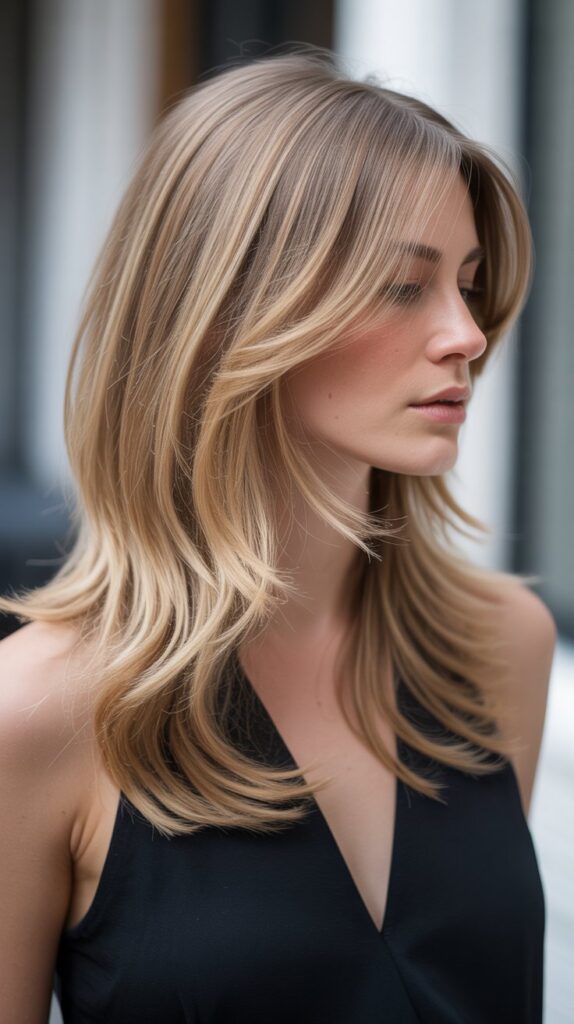
Layered haircuts remain the most versatile and universally flattering option for long hair, creating dimension and movement that prevents your hair from looking weighed down or flat.
This timeless technique involves cutting hair at different lengths throughout, which adds volume and makes styling significantly easier for everyday wear.
- Long layers work by removing bulk from thick hair while adding body to fine or thin hair textures.
- The layering technique can be customized based on where you want the most volume—starting at the crown, mid-length, or just at the ends.
- According to hairstyling experts, face-framing layers that begin around the cheekbones or chin create a slimming effect and draw attention to your best features.
- This cut requires minimal daily styling—simply blow-dry with a round brush or let it air-dry for natural texture.
- Maintenance appointments every 8-10 weeks keep the layers looking fresh and prevent split ends from traveling up the hair shaft.
2. Curtain Bangs with Long Hair
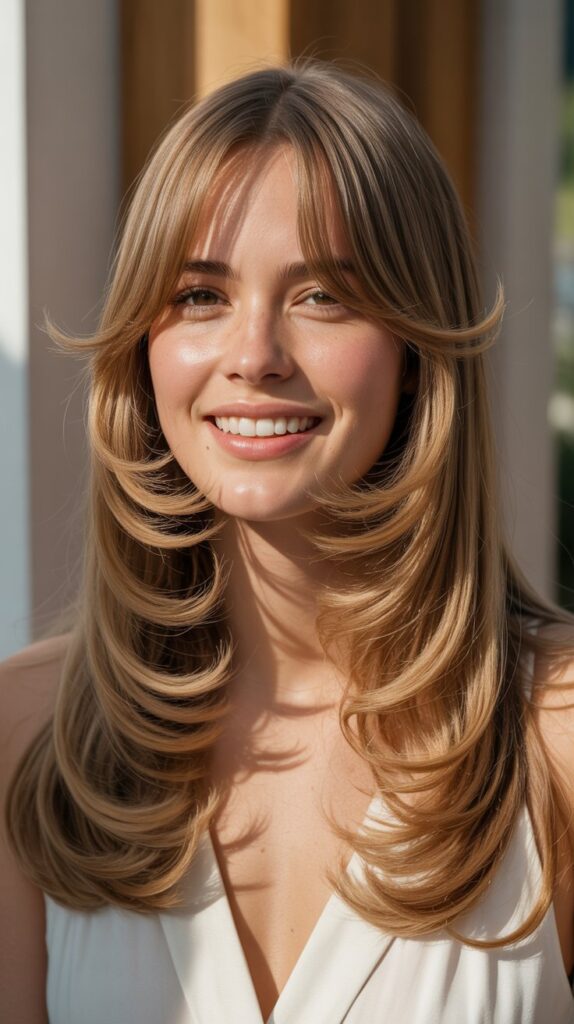
Curtain bangs have made a major comeback and pair beautifully with long hair, offering a soft, face-framing element that works for virtually every face shape.
These parted-in-the-middle bangs sweep to each side like curtains, creating an effortlessly chic look that’s both retro and modern.
- Curtain bangs are longer than traditional blunt bangs, typically falling between the cheekbones and jawline for maximum versatility.
- They require less commitment than full bangs since they blend seamlessly into your layers as they grow out.
- This style works particularly well for oval, round, and heart-shaped faces by adding width at the cheekbones.
- Styling involves blow-drying the bangs away from your face with a round brush or using a flat iron to create a gentle curve.
- The maintenance schedule is flexible—you can trim them yourself between salon visits or let them grow into longer face-framing layers.
3. V-Cut for Long Hair
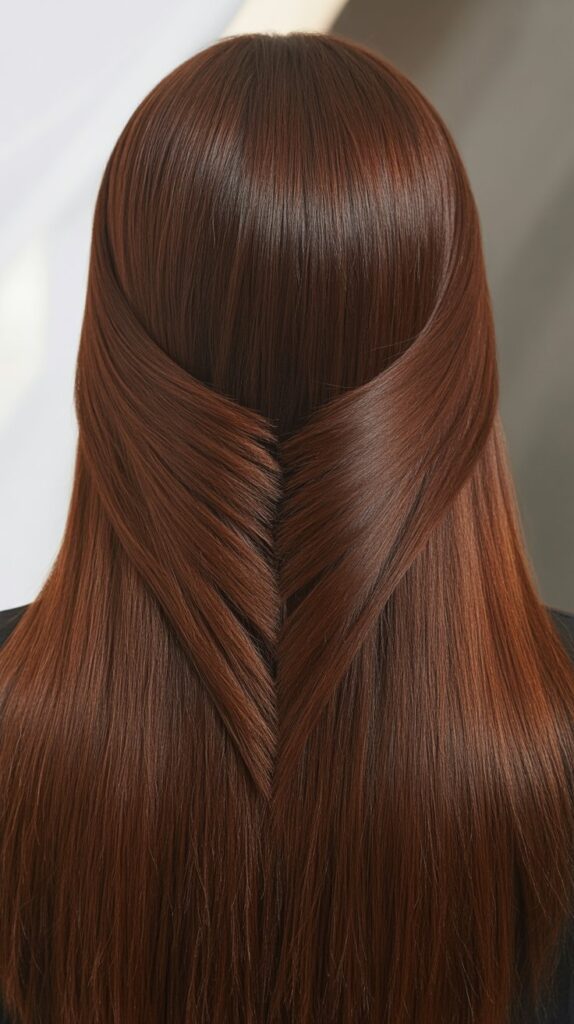
The V-cut creates a distinctive shape when hair is viewed from the back, with the longest point forming a V at the center and gradually shorter lengths toward the sides.
This geometric cut adds visual interest and works exceptionally well for those who want to maintain maximum length while adding style.
- The V-cut is ideal for those with thick, heavy hair as it removes weight while keeping the overall length intact.
- This shape creates a flattering taper that doesn’t require extensive layering throughout the hair.
- When styled in waves or curls, the V-cut produces a romantic, cascading effect that looks stunning for special occasions.
- The pointed shape emphasizes length and creates the illusion of even longer hair.
- Best maintained with regular trims every 10-12 weeks to keep the V-shape sharp and defined.
4. U-Cut for Long Hair

The U-cut is the softer sister to the V-cut, creating a gentle curved hemline that’s rounded rather than pointed.
This cut maintains a fuller appearance at the ends while still providing shape and structure to long hair.
- The U-cut is particularly flattering for those with fine to medium hair textures as it preserves density at the ends.
- This shape works beautifully with both straight and wavy hair, enhancing natural movement.
- The rounded cut creates a softer, more romantic silhouette compared to blunt or V-shaped cuts.
- It’s easier to maintain than a perfectly blunt cut since minor irregularities are less noticeable.
- The U-shape adds subtle dimension that makes hair appear fuller and healthier at the bottom.
5. Long Shag Haircut
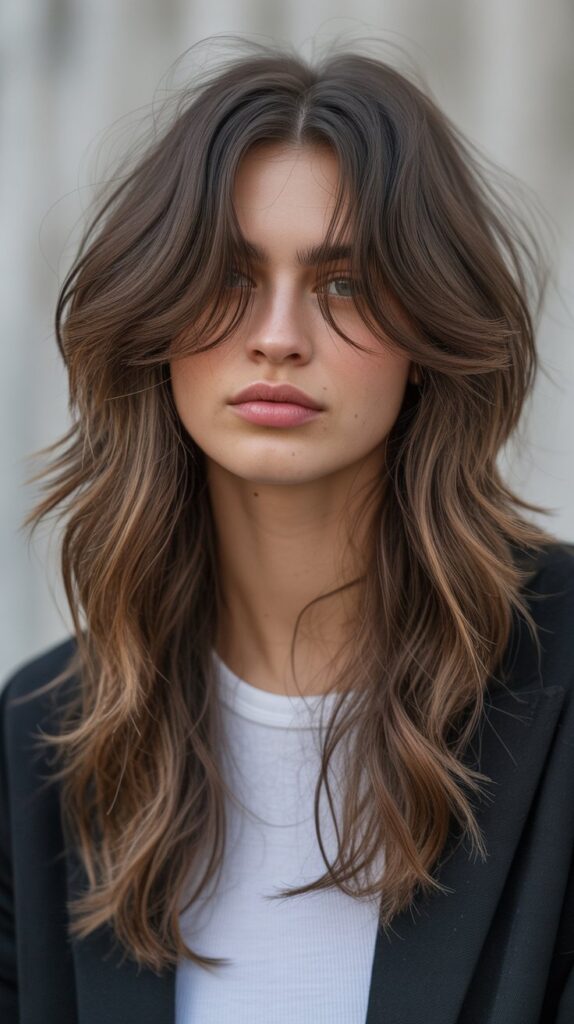
The long shag brings 70s-inspired texture and attitude to modern long hair, featuring choppy layers throughout and plenty of movement.
This cut has been revitalized by celebrities and influencers, making it one of the most requested styles in salons today.
- Shag haircuts incorporate shorter layers at the crown that gradually lengthen toward the ends, creating maximum volume on top.
- Modern shags work for all hair types but look especially striking on wavy or curly textures.
- The choppy, piece-y nature of this cut gives an edgy, lived-in appearance that doesn’t require perfect styling.
- Styling products like texturizing spray or sea salt spray enhance the shaggy, undone aesthetic.
- This cut needs regular maintenance every 6-8 weeks to prevent the layers from growing out too much and losing their shape.
6. Face-Framing Layers
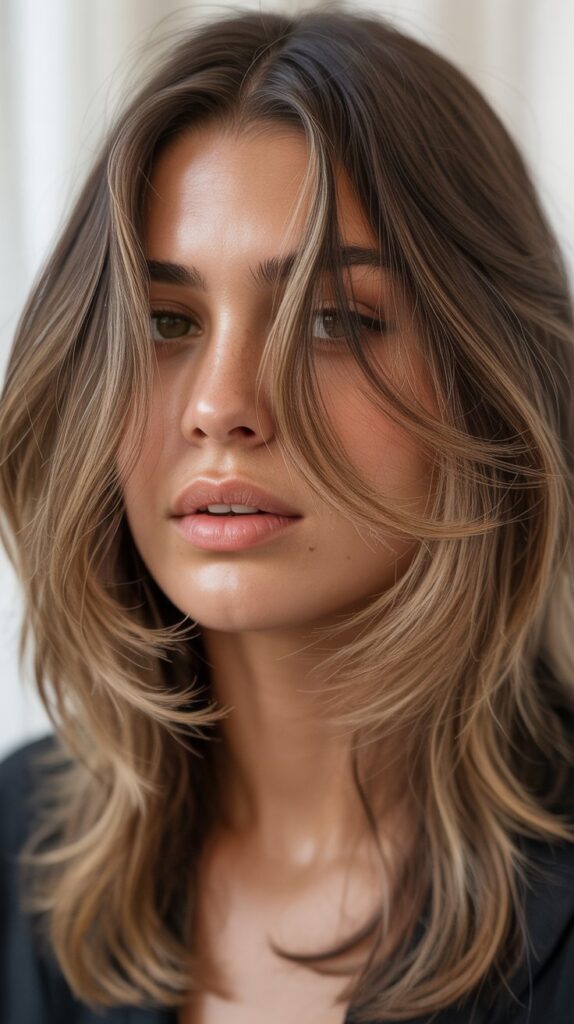
Face-framing layers concentrate shorter pieces around the face while keeping the rest of the hair long, creating a customized cut that highlights your features.
These strategic layers draw attention to your eyes and cheekbones while adding dimension without sacrificing length.
- Face-framing layers can be customized to start at any point—cheekbone, chin, or collarbone—depending on what you want to emphasize.
- These layers add movement around the face without requiring layers throughout the entire length of hair.
- The style works exceptionally well for square or round face shapes by creating angles that slim the face.
- Minimal styling is required—the layers naturally fall around your face when you brush your hair.
- This is an excellent starting point for those hesitant about getting a full layered cut.
7. Blunt Cut with Long Hair
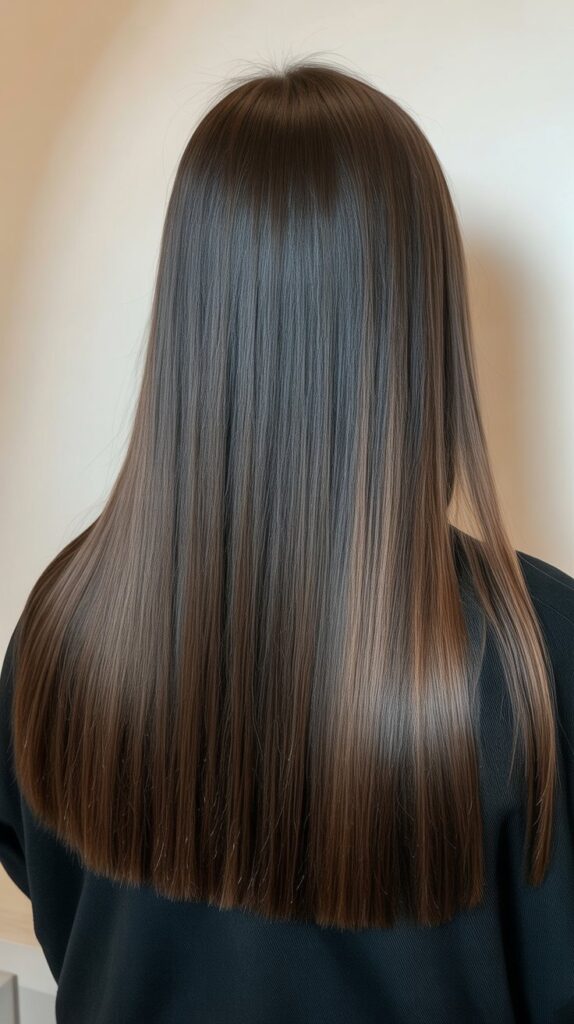
A blunt cut features a straight, even hemline across the bottom with no layering, creating a bold, modern look that emphasizes thickness and health.
This sleek style has become increasingly popular for those wanting a polished, sophisticated appearance.
- Blunt cuts make hair appear fuller and denser at the ends, which is particularly beneficial for fine or thin hair types.
- This style requires hair to be relatively healthy as the blunt line emphasizes any split ends or damage.
- Regular trims every 6-8 weeks are essential to maintain the crisp, clean line.
- The blunt cut looks most striking when styled straight with a flat iron for maximum sleekness.
- This minimalist cut works beautifully for those who prefer a simple, no-fuss hairstyle that always looks intentional.
8. Long Hair with Side Bangs
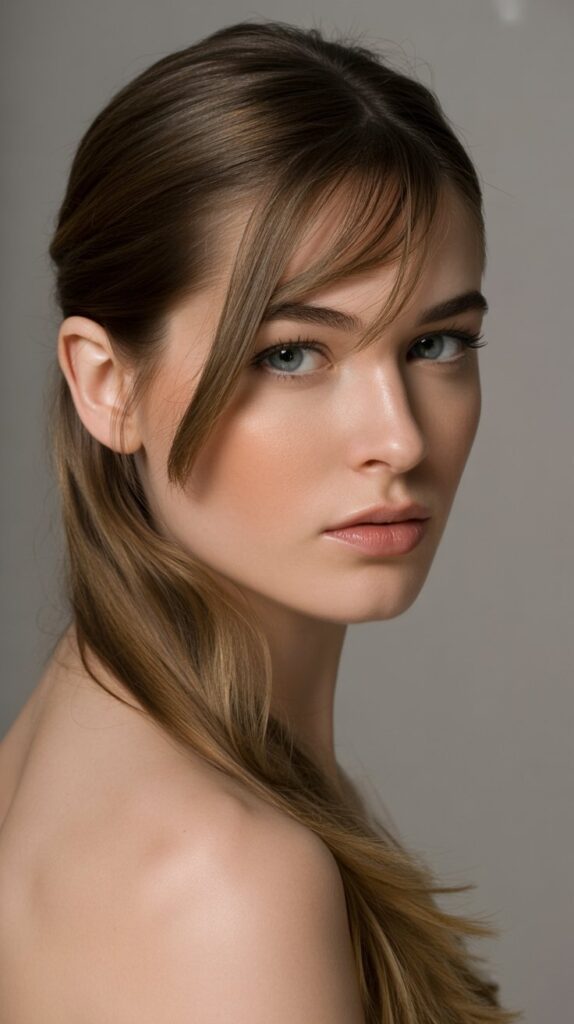
Side-swept bangs add asymmetry and softness to long hair, offering a more subtle alternative to full bangs while still changing up your look.
These angled bangs sweep across the forehead to one side, creating flattering angles.
- Side bangs work particularly well for those with high foreheads or long face shapes as they create horizontal lines.
- They’re more forgiving than straight-across bangs and can easily be pinned back when you want a different look.
- The angle of side bangs can range from subtle to dramatic depending on personal preference.
- These bangs blend more naturally into long hair and require less frequent trimming than traditional bangs.
- Styling involves blow-drying bangs in the direction you want them to sweep with a round brush.
9. Butterfly Layers

Butterfly layers, also known as butterfly haircut, feature shorter layers concentrated around the crown and face that create a distinctive lifted appearance resembling butterfly wings.
This trendy cut went viral on social media for its ability to add volume and frame the face simultaneously.
- The butterfly cut works by creating two distinct length sections—shorter layers from the crown to cheekbones, and longer layers from there down.
- This technique is especially flattering for round or square face shapes as it adds height and elongates.
- The butterfly haircut became popular because it combines the benefits of both short and long hair in one style.
- It requires more maintenance than simple layers, with trims needed every 6-8 weeks to maintain the shape.
- Styling with loose waves or curls emphasizes the layered effect and creates the signature “wing” appearance.
10. Long Hair with Feathered Layers
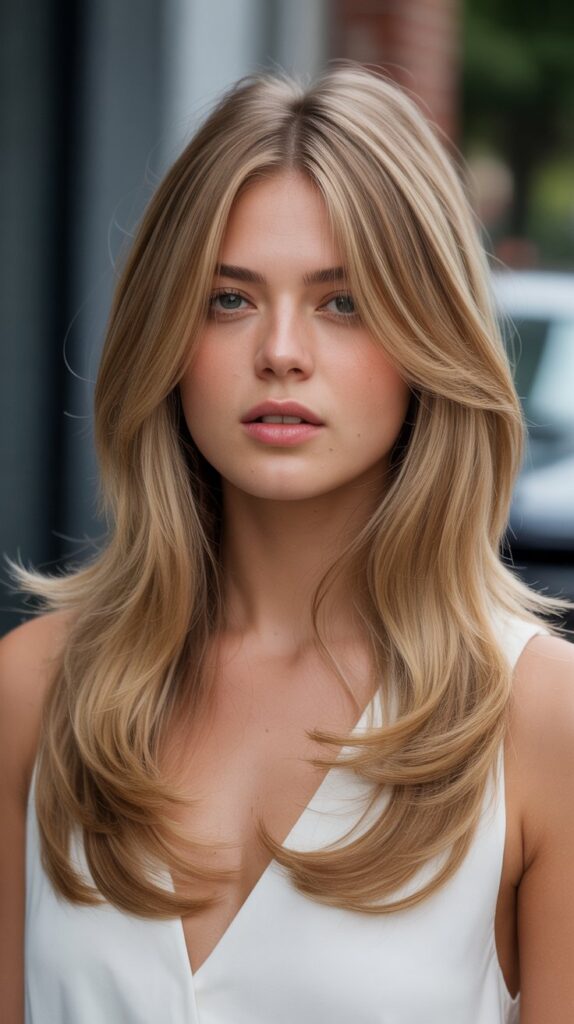
Feathered layers create soft, wispy ends that taper to fine points rather than blunt edges, producing an airy, light appearance.
This technique dates back to the 70s but has been modernized for today’s aesthetic preferences.
- Feathering involves point-cutting or razor-cutting the ends to create texture and remove weight.
- This technique is excellent for thick, heavy hair that needs to be lightened without losing length.
- Feathered layers create more movement and bounce compared to traditional blunt-cut layers.
- The style looks best when blow-dried with a round brush to flip the ends slightly outward or inward.
- Regular conditioning treatments keep the finer ends from becoming dry or damaged.
11. Long Hair with Wispy Ends
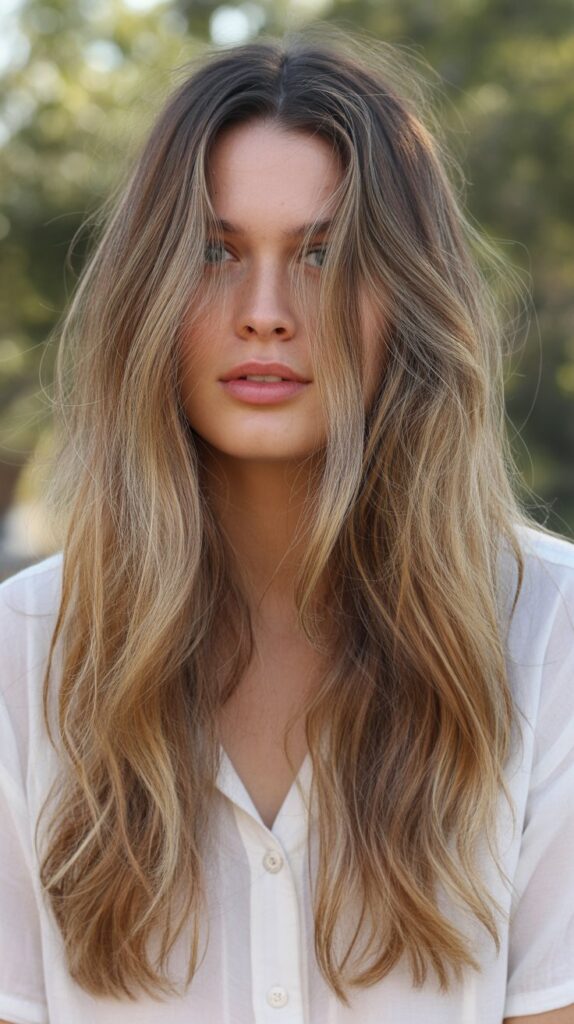
Wispy ends are created through texturizing techniques that thin out the very bottom of long hair, creating a softer, less heavy appearance.
This subtle modification makes hair look more natural and lived-in rather than freshly cut.
- Wispy ends are achieved through point-cutting or using thinning shears at the very bottom of the hair.
- This technique prevents long hair from looking too heavy or severe at the hemline.
- Wispy ends work beautifully with both straight and wavy hair textures.
- The lighter ends make hair appear more voluminous and full of movement.
- This modification requires minimal maintenance and grows out naturally without looking grown-out.
12. Long Lob with Subtle Layers
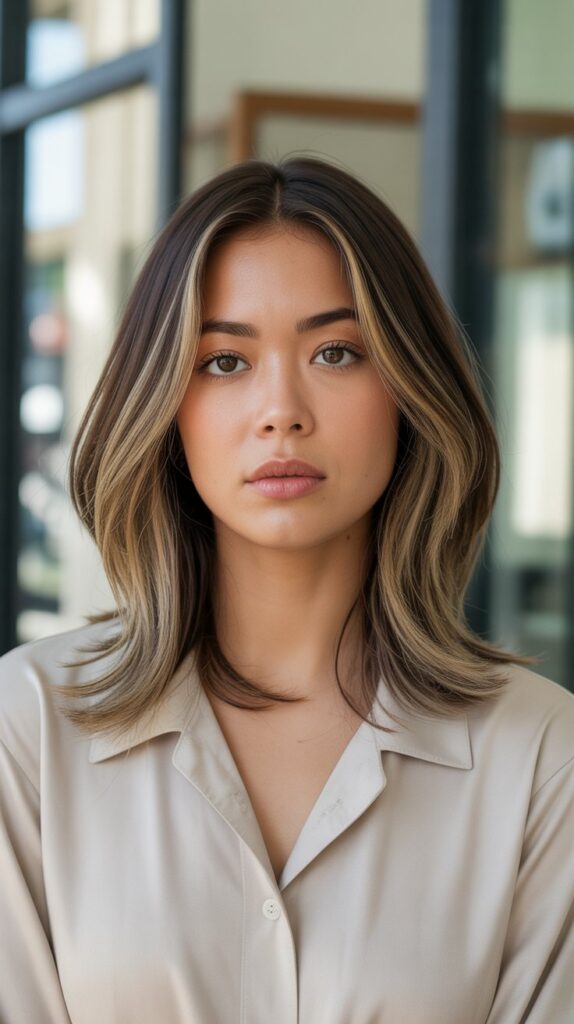
The long lob (long bob) sits between the collarbone and shoulders, technically qualifying as long hair while offering more versatility than traditional long lengths.
Adding subtle layers throughout creates dimension without dramatic layering.
- The long lob is one of the most universally flattering haircuts, working for all face shapes and hair textures.
- Subtle layers add just enough movement to prevent the style from looking too heavy or bottom-heavy.
- This length is extremely versatile for styling—easily worn straight, wavy, or in updos.
- The lob has remained popular because it offers the manageability of shorter hair with the styling options of longer hair.
- Maintenance is relatively low, requiring trims every 8-10 weeks to maintain the shape.
13. Long Hair with Choppy Layers
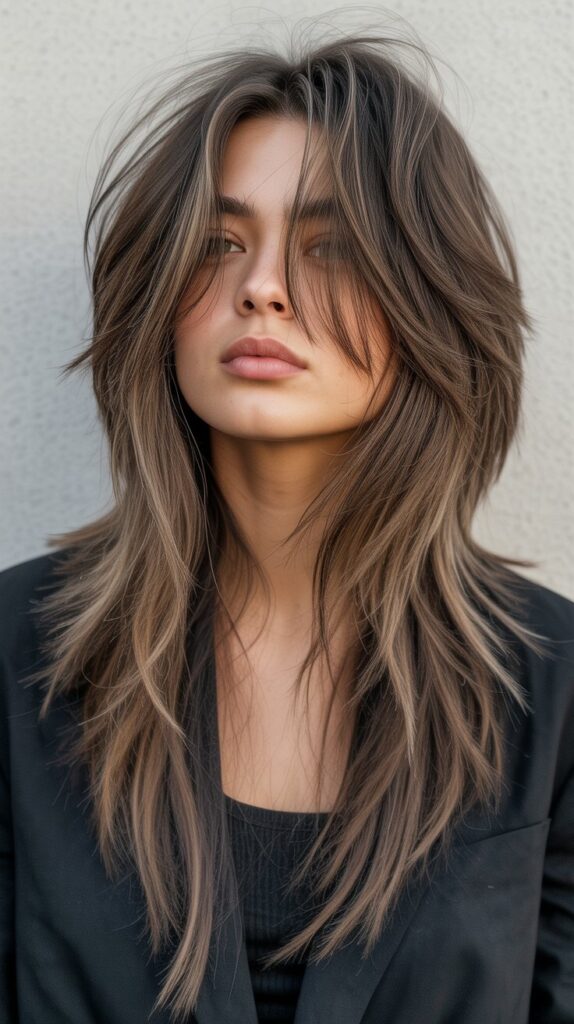
Choppy layers create an edgier, more textured look compared to traditional soft layers, with more defined separation between layer lengths.
This modern cutting technique adds attitude and dimension to long hair.
- Choppy layers are cut with more deliberate, angular techniques that create visible texture and separation.
- This style works exceptionally well for thick hair that needs significant weight removal.
- The choppy aesthetic pairs perfectly with tousled, undone styling for a cool, effortless vibe.
- These layers require less precision maintenance since the intentionally imperfect nature makes grow-out less noticeable.
- Styling products like pomade or texture paste enhance the piece-y, separated appearance.
14. Long Hair with Money Piece Highlights
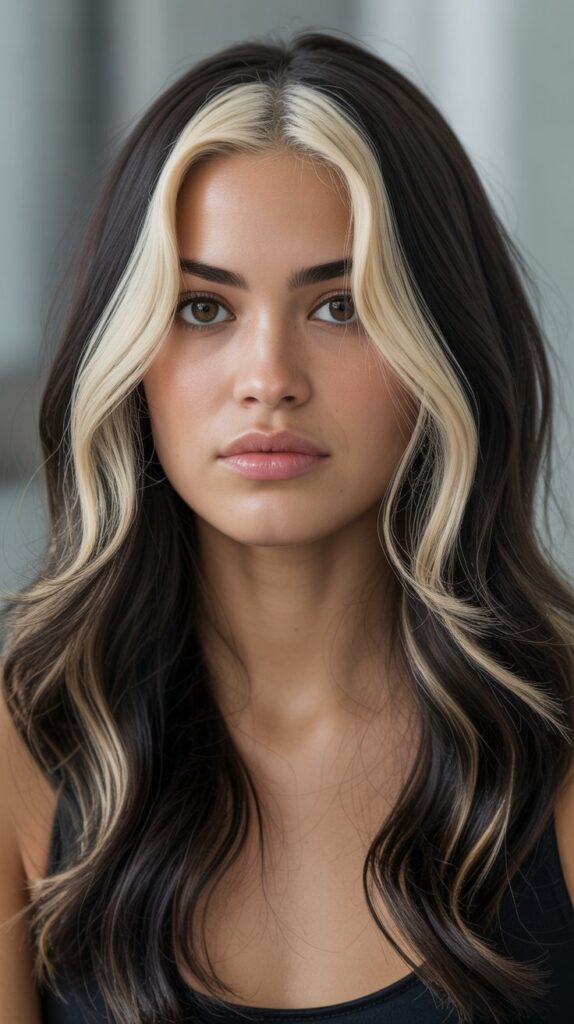
While technically a coloring technique, the money piece has become synonymous with a specific way of cutting and styling long hair that incorporates face-framing blonde pieces.
These bright sections typically include some layering to create dimension and draw attention to the face.
- Money piece highlights are thicker, brighter sections that frame the face, usually starting at the hairline.
- These highlighted pieces often incorporate subtle layering to blend seamlessly with the rest of the hair.
- The technique brightens the face and adds dimension without requiring full highlights.
- The bold contrast works particularly well with layered cuts that allow the highlighted sections to stand out.
- Maintenance involves touch-ups every 6-8 weeks to keep the bright pieces vibrant at the roots.
15. Long Hair with Hidden Layers

Hidden layers, also called internal layers, are cut underneath the top layer of hair, creating volume and movement without visible layering on the surface.
This technique is perfect for those who want the benefits of layers while maintaining the appearance of one-length hair.
- Hidden layers are cut into the interior sections of hair while keeping the perimeter length intact.
- This technique adds body and reduces bulk without creating obvious layering at the surface.
- The style is ideal for those transitioning from layered to one-length hair or who want subtle volume.
- Hidden layers make hair easier to manage and style while maintaining a sleek appearance.
- The layers reveal themselves through movement and volume rather than visible length differences.
16. Long Hair with Soft A-Line Shape
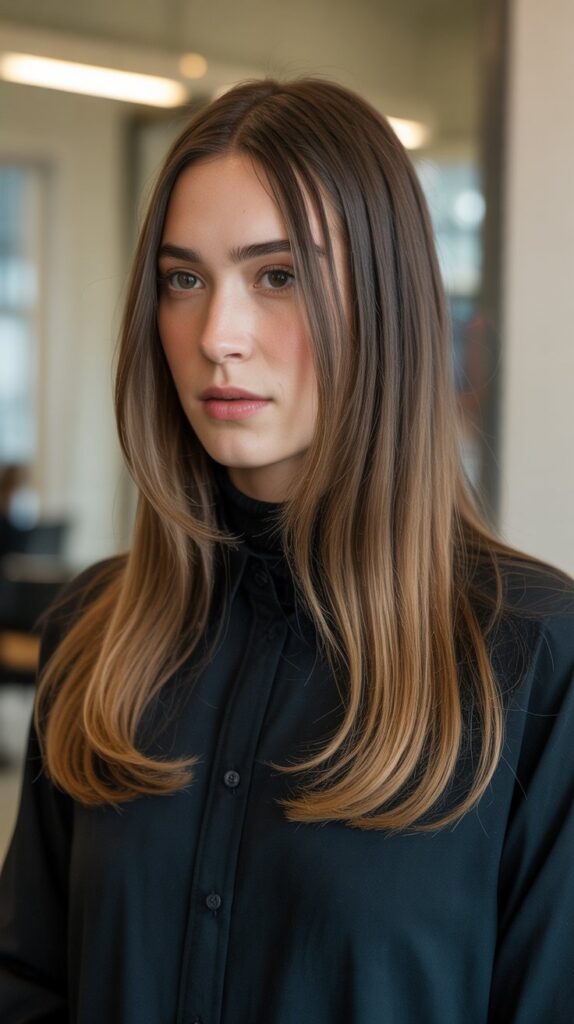
The soft A-line cut for long hair features slightly shorter pieces in front that gradually lengthen toward the back, creating a subtle angle.
This shape adds interest while maintaining significant length throughout.
- The A-line shape creates a flattering frame around the face while keeping length in the back.
- This cut works beautifully for those who want their hair to look styled even when worn down naturally.
- The subtle angle is less dramatic than traditional A-line bobs but provides similar face-framing benefits.
- This shape pairs well with both straight and wavy styling techniques.
- The cut maintains its shape well between salon visits, requiring trims every 10-12 weeks.
17. Long Hair with Crown Layers
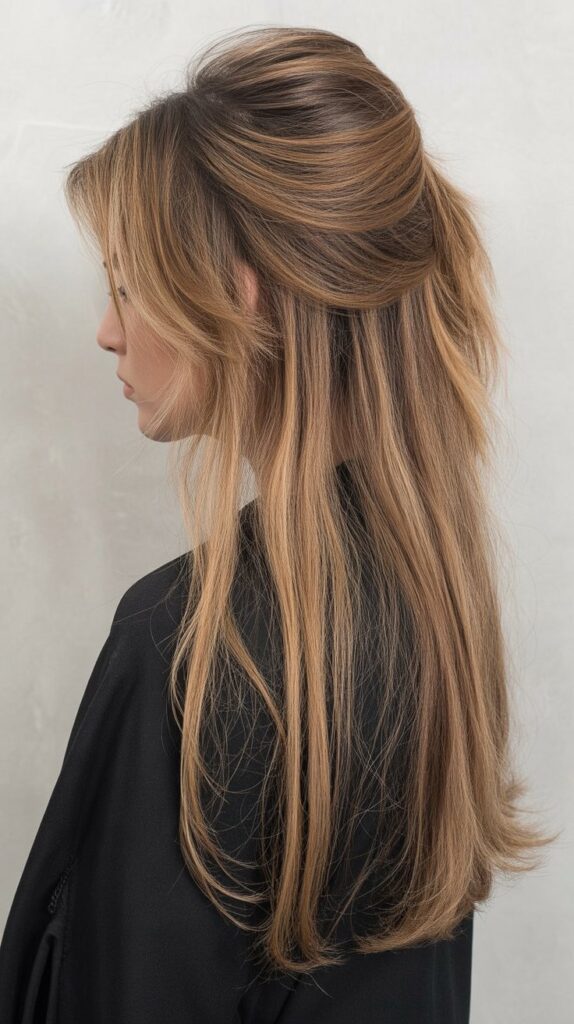
Crown layers focus shorter pieces at the top of the head to add height and volume where hair tends to lie flattest.
This strategic layering creates lift without requiring layering throughout the entire length.
- Crown layers are particularly beneficial for those with fine or flat hair that lacks natural volume.
- The shorter pieces at the crown can be cut to various lengths depending on how much lift is desired.
- These layers add the illusion of thickness and fullness without sacrificing length at the ends.
- Styling involves blow-drying the crown area with a round brush or using Velcro rollers for maximum volume.
- The technique works for all hair textures but is especially transformative for straight, fine hair.
18. Long Hair with Textured Ends
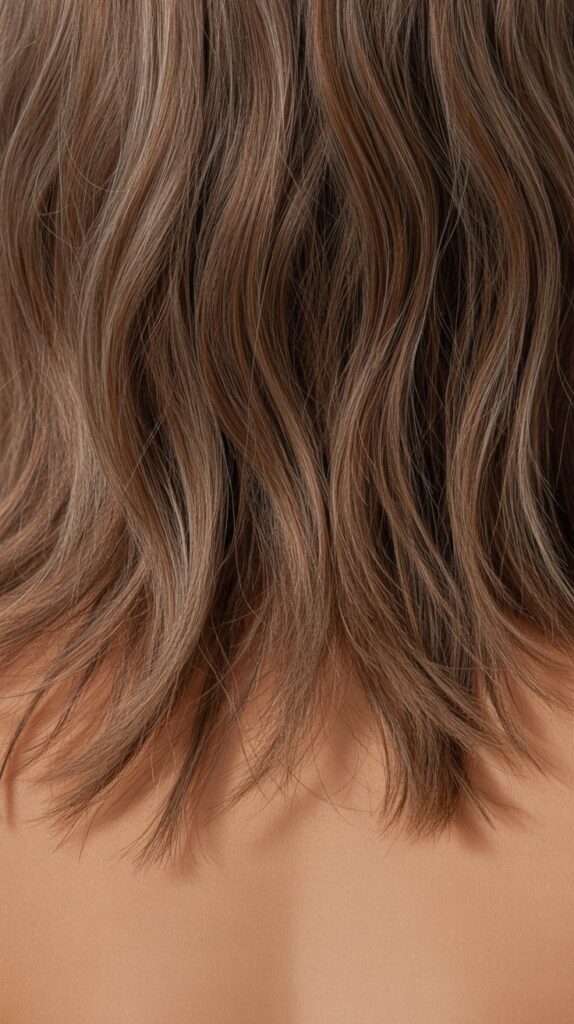
Textured ends involve using various cutting techniques—including point cutting, slide cutting, or using texturizing shears—to create varied, non-uniform ends.
This approach prevents the bottom of long hair from looking too blunt or heavy.
- Texturizing the ends removes weight and creates a softer, more natural-looking finish.
- This technique works particularly well when combined with layers for maximum movement.
- Textured ends prevent long hair from looking like it’s all one solid piece.
- The varied lengths at the bottom catch light differently, adding dimension and interest.
- This finishing technique requires skilled cutting to avoid over-texturizing, which can create a thin, straggly appearance.
19. Long Hair with Face-Framing Highlights and Layers
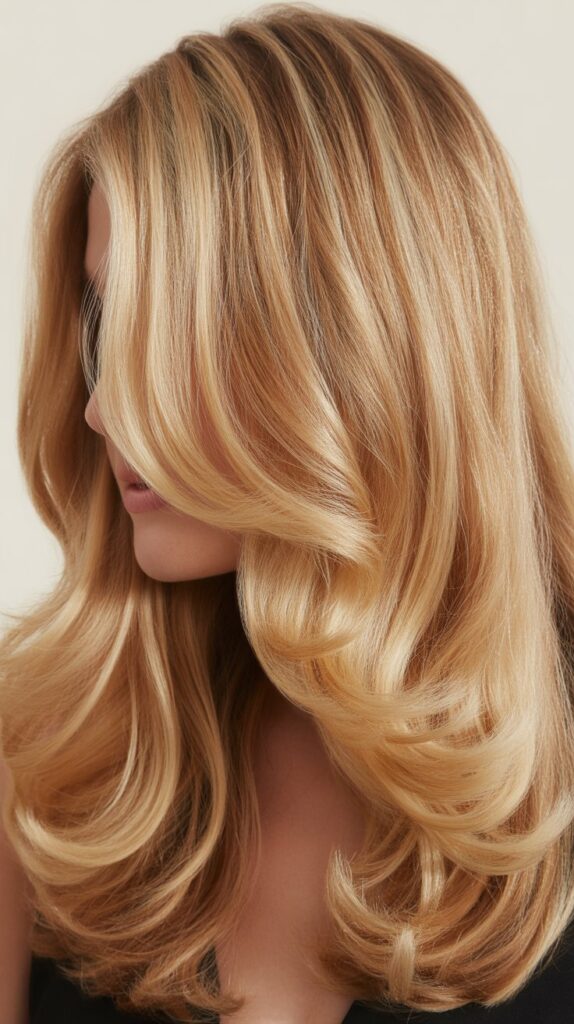
Combining strategic highlights with complementary layers creates a multi-dimensional look that adds both color and shape around the face.
This integrated approach ensures that color and cut work together harmoniously.
- Placing highlights where face-framing layers fall emphasizes the cut and adds extra dimension.
- This combination brightens the complexion and draws attention to facial features.
- The technique works best when the colorist and stylist coordinate on where to place both color and layers.
- Maintenance requires both color touch-ups and regular trims to keep the cohesive look fresh.
- This approach creates a polished, salon-fresh appearance that photographs beautifully.
20. Long Wavy Hair with Layers

Long wavy hair particularly benefits from layering, as the layers enhance natural wave patterns and prevent hair from forming a triangular shape.
Strategic layering works with the hair’s natural texture rather than against it.
- Layers in wavy hair should follow the natural wave pattern to enhance rather than disrupt the texture.
- The right layering prevents wavy hair from looking bottom-heavy or triangular.
- Wavy hair types benefit from layers that start at or below the cheekbone to maintain the wave pattern.
- Styling is minimal—often just air-drying with a curl-enhancing product produces beautiful results.
- Regular trims every 8-10 weeks keep the layers fresh and prevent the ends from looking stringy.
21. Long Straight Hair with Minimal Layers
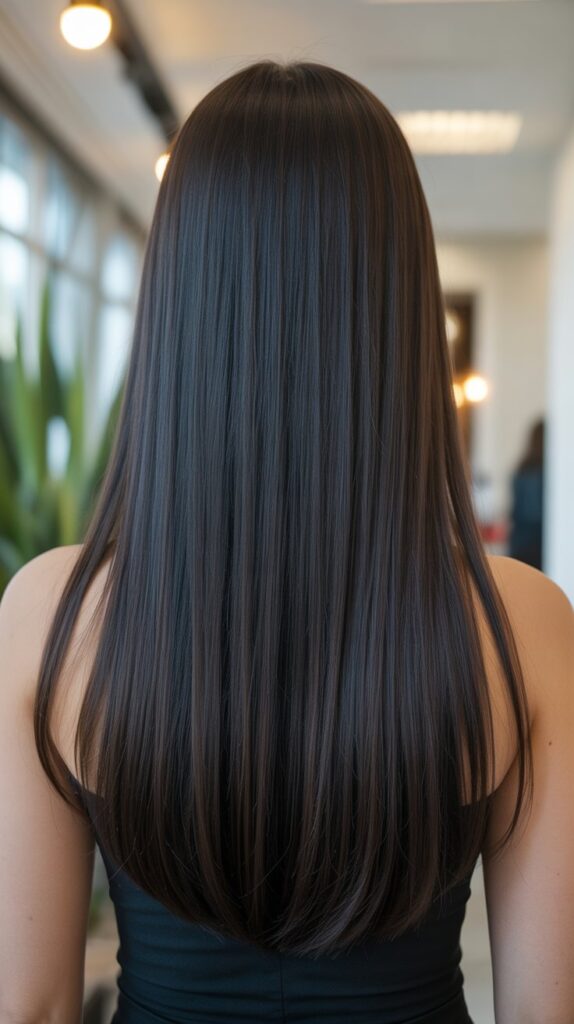
For those with naturally straight hair who want to maintain a sleek, polished appearance, minimal layering provides just enough movement without disrupting the straight texture.
This approach keeps hair looking intentionally one-length while preventing flatness.
- Minimal layering involves only slight graduation at the ends rather than distinct layers throughout.
- This approach maintains maximum density and the appearance of one-length hair.
- The subtle layers prevent straight hair from looking too severe or blunt while keeping it sleek.
- This style requires the least maintenance of any layered approach, with trims needed only every 10-12 weeks.
- The sleek, minimal aesthetic works well for professional settings and formal occasions.
22. Long Hair with Waterfall Layers
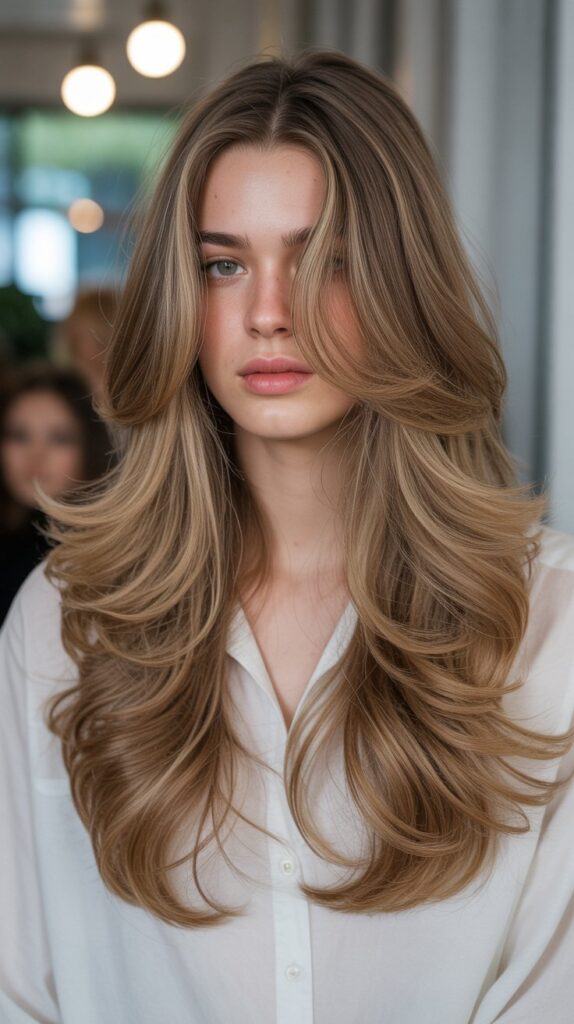
Waterfall layers create a cascading effect with multiple distinct layer lengths that flow into each other like a waterfall.
This romantic style adds significant movement and dimension to long hair.
- Waterfall layering involves cutting several distinct length points throughout the hair for maximum dimension.
- This technique creates the most dramatic layered effect and works best with thick, healthy hair.
- The cascading layers are particularly stunning when styled with waves or curls.
- This style requires committed maintenance with trims every 6-8 weeks to keep the layers distinct.
- The dramatic effect makes this cut ideal for those who want their hair to make a statement.
23. Long Hair with Razored Layers

Razor cutting creates soft, feathered layers with tapered ends rather than blunt cuts, producing an airy, textured appearance.
This technique removes weight while adding movement and is particularly effective for thick hair.
- Razor cutting uses a razor blade instead of scissors to create softer, more blended layers.
- This technique is excellent for removing bulk from thick hair without creating harsh lines.
- Razored layers require an experienced stylist as incorrect technique can cause damage.
- The soft, feathered effect works beautifully with tousled, natural styling.
- Hair cut with a razor may require more frequent conditioning treatments to keep ends healthy.
24. Long Hair with Graduated Layers
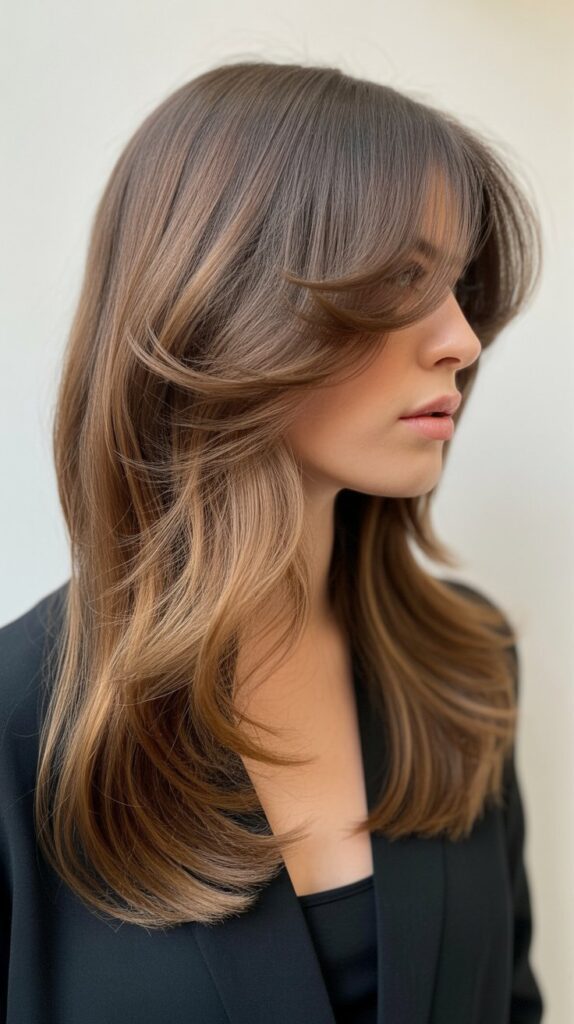
Graduated layers feature a systematic, stacked approach where each layer is slightly longer than the one above it, creating a dome-shaped silhouette when viewed from the side.
This structured approach adds volume and shape to long hair.
- Graduated layering creates maximum volume at the crown area while maintaining length.
- This technique is particularly effective for fine hair that needs body and movement.
- The structured approach produces a more polished, intentional look compared to random layering.
- Graduated layers work well when blow-dried with a round brush to emphasize the volume.
- The cut requires precision maintenance every 8-10 weeks to keep the graduation looking fresh.
25. Long Hair with Swoopy Layers

Swoopy layers are cut and styled to curve gently away from or toward the face, creating movement that “swoops” with natural flow.
This playful style adds personality and dimension to long hair.
- Swoopy layers are cut at angles that encourage hair to curve naturally when styled.
- This technique works particularly well for those who regularly blow-dry or use hot tools.
- The swooping effect adds a youthful, vibrant quality to long hair.
- Styling involves directing hair with a round brush in the direction you want the swoop to go.
- The playful movement makes this cut ideal for those with naturally straight or slightly wavy hair.
26. Long Hair with Piece-y Layers
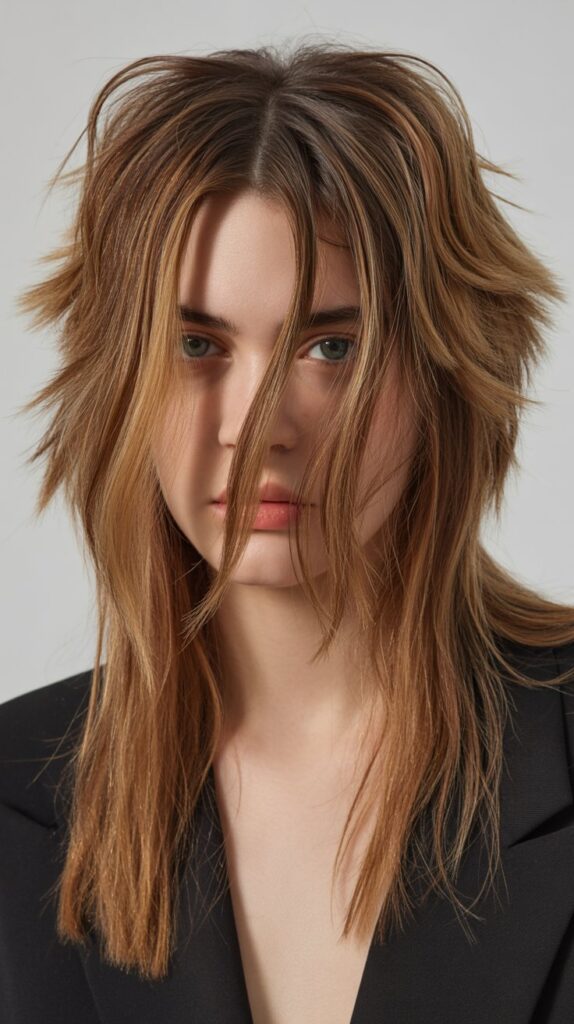
Piece-y layers create separation and texture with defined individual sections rather than blended, seamless layers.
This modern approach adds an edgy, fashion-forward element to long hair.
- Piece-y layers are achieved through point-cutting and texturizing techniques that create definition.
- This style works best with styling products that enhance separation like pomade or texture paste.
- The look is intentionally less polished and more editorial or fashion-forward.
- Piece-y layers help thick hair look less dense while adding personality.
- The textured appearance makes this cut perfect for those who prefer a lived-in, undone aesthetic.
27. Long Hair with Subtle Balayage and Layers
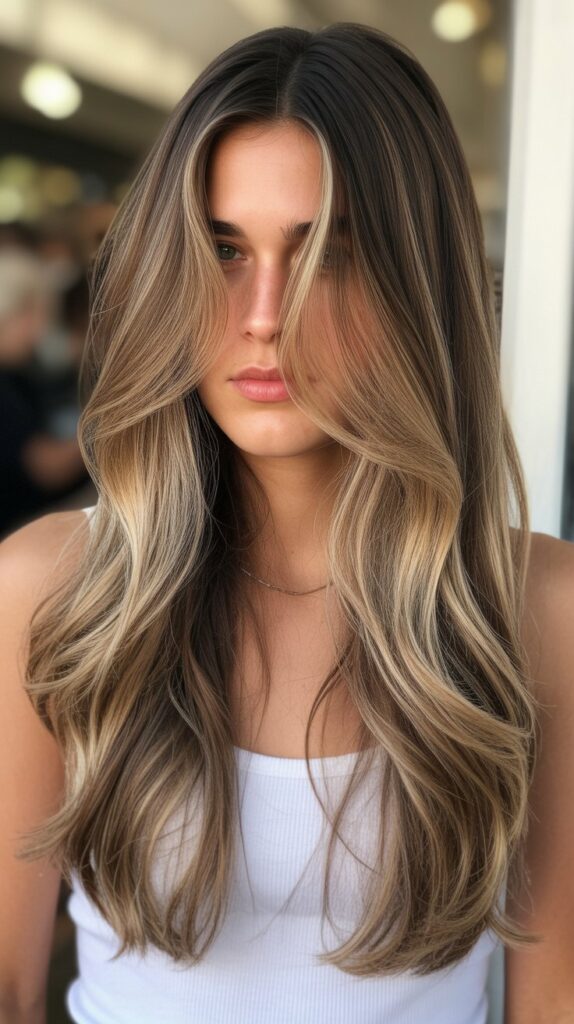
Combining balayage coloring technique with strategic layering creates a sun-kissed, dimensional look where color and cut enhance each other.
The layers provide placement for lighter pieces that add depth.
- Balayage placed on layered sections creates natural-looking dimension that mimics how sun naturally lightens hair.
- The combination of color and cut adds multiple layers of dimension—both literal and visual.
- This approach works for all base colors, from blonde to brunette to red.
- Balayage with layers creates a low-maintenance look that grows out beautifully.
- Maintenance involves color refreshes every 10-12 weeks and regular trims to keep layers fresh.
28. Long Hair with Disconnected Layers
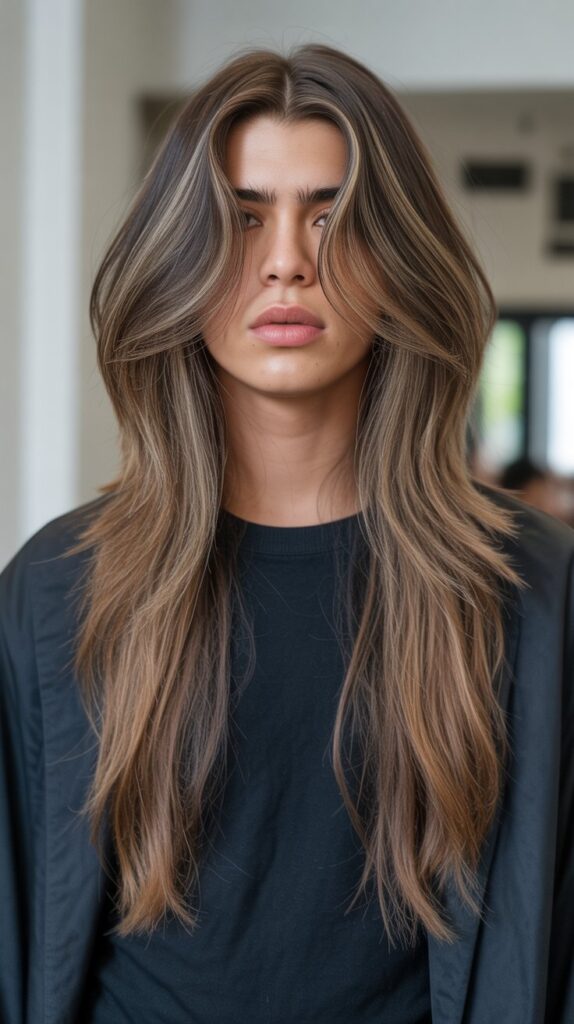
Disconnected layers feature more dramatic differences between layer lengths, creating intentional “steps” rather than seamless blending.
This bold approach adds significant dimension and makes a statement.
- Disconnected layering creates more obvious length variations for a dramatic, editorial effect.
- This technique works best for thick hair that can handle the removal of significant weight.
- The bold layering creates interesting silhouettes from all angles.
- Styling can emphasize or minimize the disconnection depending on whether hair is worn straight or curly.
- This cut requires commitment to the look and regular maintenance to keep the shape intentional rather than grown-out.
29. Long Hair with Side Part and Layers
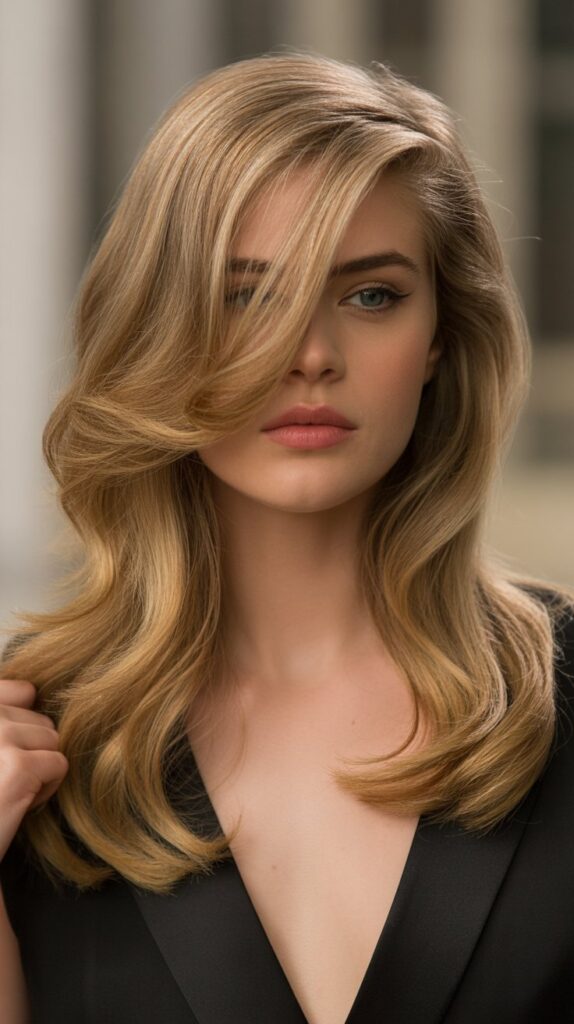
Pairing long layers with a deep side part creates asymmetry that adds interest and modernity to classic long hair.
The side part allows layers to fall differently on each side for dimension.
- A deep side part creates volume on one side while the other appears sleeker.
- Combining a side part with layers creates natural face-framing without requiring specific face-framing cuts.
- The asymmetrical styling works particularly well for formal occasions and photographs.
- Side parts can make hair appear fuller by exposing more root area.
- This styling approach works with virtually any layered cut for instant drama.
30. Long Hair with Curly Layers

Curly hair has unique needs when it comes to layering—layers must be cut according to the curl pattern to avoid creating unwanted volume or shape.
Proper curly layering enhances natural texture beautifully.
- Curly hair should be cut dry so the stylist can see the natural curl pattern and layer accordingly.
- Layers in curly hair prevent the dreaded pyramid or triangle shape that occurs when curly hair has too much weight.
- Curly layering should follow the curl’s natural spiral to enhance rather than disrupt the pattern.
- The right layers allow curls to stack and spiral beautifully without creating frizz.
- Curly hair benefits from specialized cutting techniques like the DevaCut or Rezo cut for best results.
31. Long Hair with Peek-a-Boo Layers
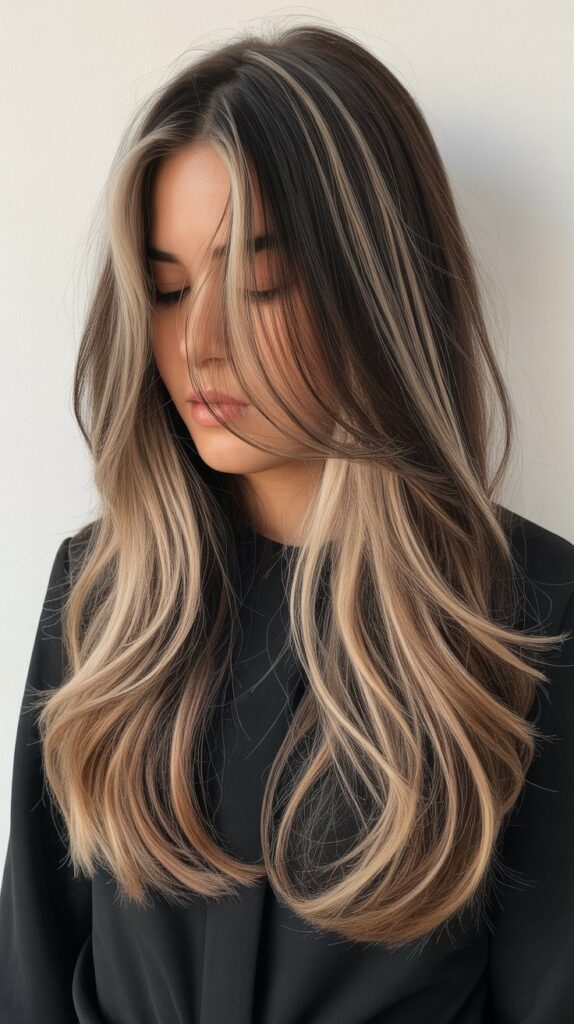
Peek-a-boo layers are hidden shorter layers underneath longer surface layers that reveal themselves with movement.
This playful technique adds surprise elements and hidden dimension to long hair.
- Peek-a-boo layers create hidden interest that appears only when hair moves or is styled differently.
- This technique is often combined with hidden color for an even more dramatic reveal.
- The hidden layers add volume and movement without changing the overall silhouette dramatically.
- This approach is perfect for those who want options—the ability to show or hide the layers.
- Styling can emphasize the hidden layers by flipping hair or wearing it in certain updos.
32. Long Hair with Soft Blended Layers
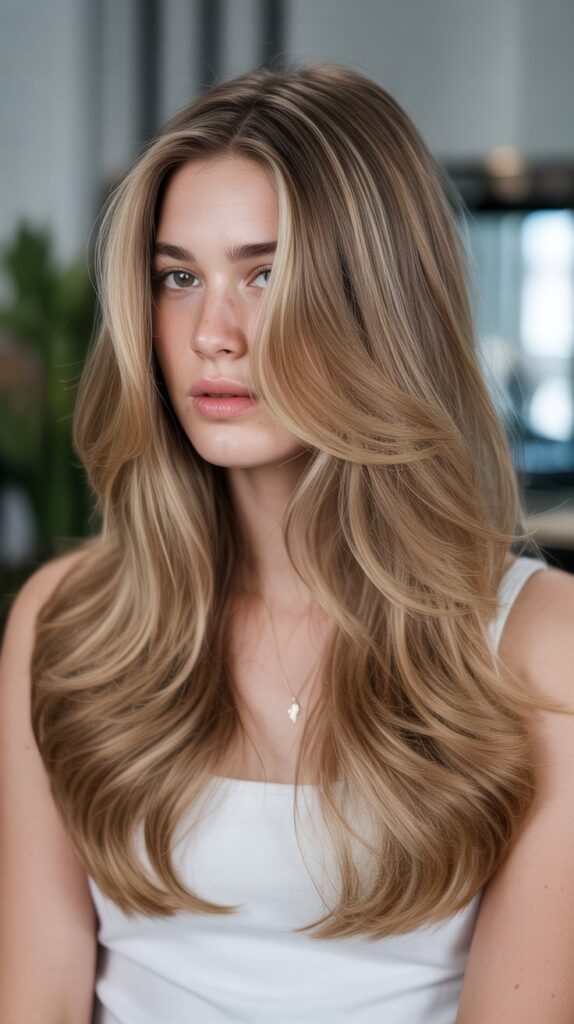
Soft blended layers create seamless transitions between lengths with no harsh lines or visible steps.
This classic approach to layering produces the most natural-looking dimension.
- Blended layers use careful cutting techniques to ensure each layer melts into the next.
- This approach creates the most natural, lived-in appearance without obvious layering.
- Soft blended layers work for all hair types and textures.
- The seamless blending makes grow-out less noticeable, extending time between cuts.
- This classic technique never goes out of style and works for any age or aesthetic.
33. Long Hair with Dimensional Layers and Highlights
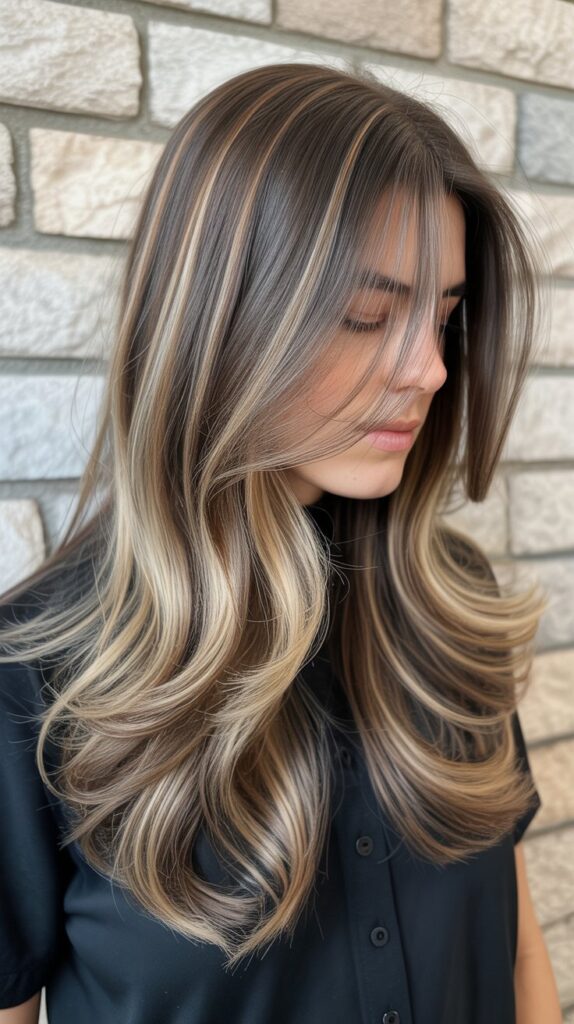
Combining multi-tonal highlighting with strategic layering creates maximum dimension, where both color and cut work together to create depth and interest.
This comprehensive approach transforms long hair completely.
- Dimensional coloring places lighter and darker pieces throughout the layers for depth.
- The layering provides perfect placement for color that creates natural-looking dimension.
- This combination approach requires coordination between cutting and coloring services.
- The multifaceted result creates hair that appears thick, healthy, and professionally maintained.
- Maintenance involves both color services and regular trims, typically every 8-10 weeks for optimal results.
Conclusion
Finding your perfect style among these 30+ Cute Haircuts for Long Hair You’ll Want to Try opens up a world of possibilities for transforming your look while keeping the length you’ve worked hard to grow.
Whether you’re drawn to the effortless movement of long shag layers, the sleek sophistication of a blunt cut, or the face-framing beauty of curtain bangs, there’s a cut here that will complement your features, work with your hair texture, and fit your lifestyle.
The key to choosing the right haircut lies in considering your hair type, face shape, styling commitment, and personal aesthetic preferences.
Take these ideas to your trusted stylist, show them the image prompts that resonate with you, and work together to customize a cut that makes you feel confident and beautiful every single day.
Your dream long haircut is waiting—all you need to do is take the leap and book that appointment.
